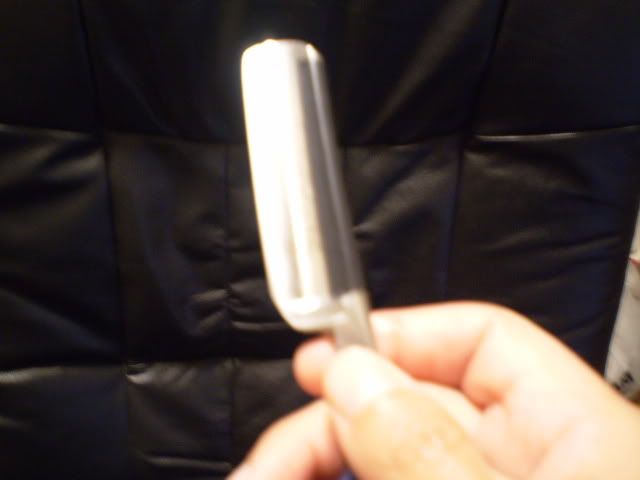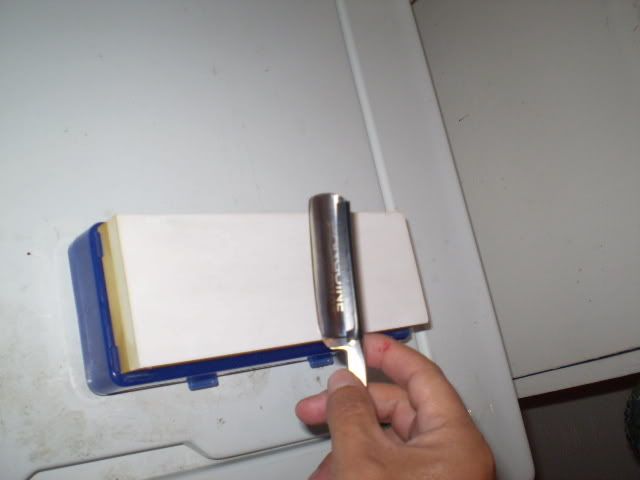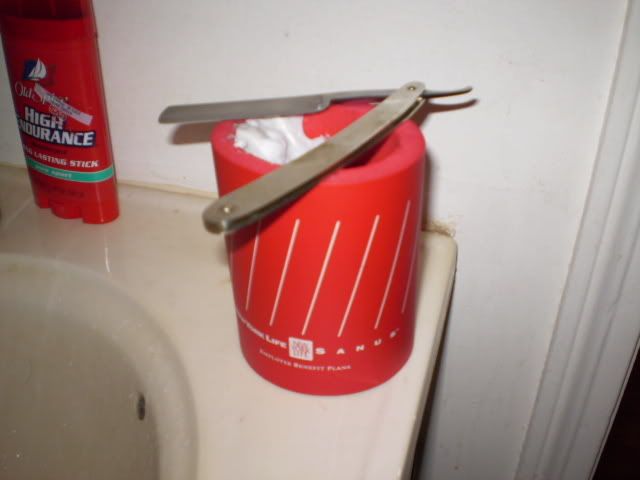Results 1 to 10 of 13
Thread: Taping the spine?
-
02-24-2008, 05:47 AM #1
 Taping the spine?
Taping the spine?
G'day. The idea of taping the spine with electrical tape has always had me stumped. I have a vision of blue plastic being dragged all over my hone. Maybe my idea of electrical tape is different.Is there a picture somewhere of the set up? I'm obviously way off the mark with this one.
Thanks
Brian
-
02-24-2008, 06:33 AM #2

I always tape my spines before honing. This is a decision you must make early on your path of straight razor shaving as this changes the bevel of your razor quite a bit. I feel that taping protects the spine and appearance of razors and makes for a more gentle shave. The bevel is adjusted so that the skin is not directly exposed to the blade itself (I mean, it is exposed but microscopically, there is a slant between the skin and actual blade). I make sure that the tape is below the shoulder of the blade. Don't let the tape overlap over the shoulder! Taping above and past the shoulder will mess up everything and make for an uneven hone!


I then proceed to hone as usual. Once the Norton is thoroughly wet, the tape slides effortlessly over the hone. Make sure that the tape is tight over the spine to keep it from coming up during the honing process. If the tape get loose due to water getting in under it; you should remove the wet tape, dry the blade and put a new piece of tape over the spine. After honing, clean your Norton with light grit automotive grade sanding paper, like a 600 grit and use a good flat sanding block. The tape can leave a residue but this can be cleaned off easily with a light sanding.
Ernest

Last edited by Big_E; 02-24-2008 at 08:06 AM.
-
02-24-2008, 08:38 AM #3

Thanks Big E. A very comprehensive answer. I'll keep that info tucked away and give it go. I can see the advantage.
Thanks
Brian
-
02-24-2008, 09:05 AM #4Senior Member

- Join Date
- Sep 2007
- Posts
- 711
Thanked: 22
I was actually thinking about this part the other day, although I have not got a razor just yet that needs to be taken to a lower grit than my natural Japanese hones. I imagine oneday I will have a crappy razor that needs a good honing, but I imagine that the tape wears down just like metal and maybe a little faster, thus as its wearing down, the bevel angle will be changing ever so slightly as it would if you hadn't taped the spine. So the question is if the tape has been wearing down and chaniging the angle, wouldn't replacing the tape at any point throughout the honing process, be the same as throwing a spanner in the works, going from a shallow angle back to a high one? I know the height/angle difference would probably be neglagable, with straight razors I was to understand even the slightest change can mess things up.
I hope this makes sense and you understand it.
-
02-24-2008, 10:37 AM #5Senior Member

- Join Date
- Feb 2008
- Location
- Iowa
- Posts
- 181
Thanked: 2 Taping the spine
Taping the spine
I've been under the impression that only the damascus razors need be taped to protect the fancy file work.
Limit
-
02-24-2008, 11:23 AM #6

yes and no... I will sometimes change the tape if it wears through on the lower grits, but increasing the angle by 1/2 a degree isn't going to hurt the final product. I always tape the spine when i hone, and have never had a problem. the most important thing about the edge is the thickness of the edge, not the exact angle of the bevel.
Zowada adds 2 pieces of tape and creates a micro bevel when honing his razors... and they shave just fine... you could probably add 5 and still be fine.
when you get to that level of honing, pressure will make more of a difference than tape, and the tape wears slowly enough that your edge isn't really affected.
replacing the tape may create a micro bevel, but it will be sharp, and the micro bevel will be so fine that 5 or 6 strokes on an 8k will remove it.
stropping without the tape works just fine, as does finishing on 0.25 diamond paste without the tape
so yes it will change things, but on such a small scale that you won't see any difference. I've been told that feather razors have 3 distinct bevels...
need being the key word... no razor absolutely needs tape on the spine... the tape is cosmetic, it protects the spine from wear. eventually the tape could be detremental if the blade wears down and the spine doesn't the angle would get too steep, but it would take a very long time... the tape just keeps new razors looking new longer.I've been under the impression that only the damascus razors need be taped to protect the fancy file work.
LimitLast edited by Mike_ratliff; 02-24-2008 at 11:26 AM.
-
02-24-2008, 12:30 PM #7

Well I'll be trying this taped spine method sooner than I expected. Just dinked my minty looking puma on the tap. Two nice looking chips the result. Not real big but I want to protect the spine on this one. Will wait for the weekend and will do a bit of practicing.
Wish me luck
Brian
-
02-24-2008, 01:00 PM #8
-
02-24-2008, 06:06 PM #9

Oh man! I hate to hear that. I was actually thinking about mentioning (bragging) that I don't let my razors contact any water while shaving, but I didn't want to sound like a smarty-pants. I carefully wipe the lather off the blade using the back of my hand or will wipe off on one of those foam can coolers. I keep one by the sink. The only moisture my razors come into contact with is the shaving lather (high alkalinity, wont hurt blade) and the water on the hone. But this info's too little too late in this case.
Ernest

-
02-24-2008, 06:51 PM #10

The answers so far have been pretty good, but I wanted to add a couple of points.
First, rust is something of a concern when using tape, as has been pointed out. Mainly what happens for me is a bead of water gets under the tape right at the tip of the razor, where the spine starts to curve down to form the point. This doesn't seem to be a problem while you're honing--maybe the honing stroke flushes the area constantly, preventing the water from stagnating. But if you set a razor down with tape on its spine and leave it for more than a few minutes, there's a good chance you'll get some rust spots.
Also, the tape only wears away if you're doing heavy honing on coarse hones. On a 1K hone, tape would last for hundreds of normal strokes. If you used pressure, you'll start to see it wear. My 325 and 600 grit hones eat tape pretty quickly. But when I resort to these, the razor's in pretty bad shape to begin with, and a half-degree of change in angle is the least of my worries. If I'm taking out a huge chip and reestablishing the bevel, I'll often replace the tape three or four times. The final honing will be done with fresh tape, or sometimes I'll just leave the tape off for the last bit of honing on the 1200-grit hone to establish a normal bevel.
My general approach is that I tape wedges and decorative spines and do everything else without tape. Wedges just develop nasty hone wear if you don't tape them.
Josh


 LinkBack URL
LinkBack URL About LinkBacks
About LinkBacks






 Reply With Quote
Reply With Quote

